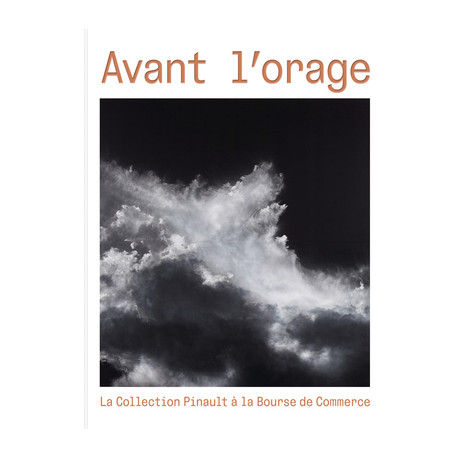No products
Product successfully added to your shopping cart
There are 0 items in your cart. There is 1 item in your cart.
Exhibition catalogue
- New Art Books
- Exhibition catalogue
- Highlights
- Art Book Sale
- Museum's Shop & Gifts
- Bilingual art books and foreign editions
- Children's Books
- Art History
- Painting
- Architecture
- Sculpture
- Drawing & Engraving
- Photography
- Contemporary art
- Decorative Arts & Design
- Art Techniques
- Critics
- Entertainment art books
- Civilisations
- Partners Reviews

Avant l'orage - Pinault Collection
The cycle of exhibitions presented by the Pinault Collection entitled Avant l’orage (Before the Storm), invites visitors on a journey from shadow to light, through installations and works, some iconic, others new, by some fifteen artists, throughout the spaces of the Bourse de Commerce.
Shipped within 3 to 6 days
| Model | 9782373721553 |
| Artist | Art contemporain |
| Author | Emma Lavigne, James Lingwood, Nicolas-Xavier Ferrand, Caroline Bourgeois, Jean-Marie Gallais |
| Publisher | Dilecta / Pinault Collection |
| Format | Ouvrage relié |
| Number of pages | 256 |
| Language | Bilingue Français / English |
| Dimensions | 280 x 220 |
| Published | 2023 |
| Museum | Bourse du Commerce - Pinault Collection, Paris |
Exhibition Catalogue « Avant l’orage », presented at the Bourse du Commerce - Pinault Collection, Paris (Until 11 september 2023).
Against the backdrop of the climate crisis, in the urgency of the present, before the storm breaks again, the artists in the exhibition invent unusual ecosystems that contain new seasons.
Whereas ancestral calendars were conditioned by cosmic movements, our frantic race for progress and abundance has irrevocably transformed our environment. Its disruption forces us to adapt in turn. Formerly the granary of Paris, the Bourse de Commerce building has been both a witness to and an agent in the global acceleration of predatory trade since 1889, resulting from colonisation and the intensive exploitation of the planet’s resources. The building embodies this new, desynchronised cycle of time. In the iron, glass, stone, and concrete architecture of the Bourse de Commerce, which could be that of a greenhouse, a series of fleeting and contradictory temporalities appear, including the landscape imagined by Danh Vo for the Rotunda.
In the other spaces, a display from the Pinault Collection supports this birth of a new cycle of seasons in the making, of mutating ecosystems, of micro-territories in gestation, bathed in a light approaching a mutating climatic dusk. Hicham Berrada’s Présage, which immerses the visitor in a landscape in the throes of transformation, makes us aware of the beauty of a world without us. Diana Thater’s Chernobyl takes us into an irradiated landscape, an apocalyptic theatre, while Pierre Huyghe’s film follows the movements of a monkey wearing a human mask, abandoned in the outskirts of Fukushima. Robert Gober’s Waterfall depicts a trompe l’oeil nature from which we are irretrievably separated, while Pierre Huyghe’s Untilled (a play on the words “untitled” and “uncultivated”) recreates the world as experienced by non-humans, from dogs to insects, in a compost committed to new possibilities for fertilising the world.
In Lucas Arruda’s work, tiny mental landscapes make up a universe of indistinctions, where pitch-black skies and toxic sfumati give way to invented colours that are difficult to discern. Painting becomes at once organic, chromatic, and poisonous in the traces that Thu Van Tran deposits on the surfaces of the white cube from the rubber resulting from colonial exploitation in the Amazon and Asia since the late nineteenth century. In Anicka Yi’s work, vegetal cocoons give birth to robotic insects, blurring the line between the natural and the artificial, as with Donna Haraway’s cyborg, in which all the dualisms of modernity are cancelled out in order to better embrace the porosities between beings and identities. These mutations were already announced in Alina Szapocznikow’s hybrids, in which the human body mingles with the plant as well as with the object. In one of the texts in his collection Lilith and Other Stories, Primo Levi uses the term “disphylaxis”, the accidental mixing of genes between plants and humans. Rooted in the soil, dependent on the wanderings of the sun, we share the condition of plants, of all the living beings that surround us. The relational nature of our humanity is also expressed in Daniel Steegmann Mangrané’s dialogue with Cy Twombly, in which the American painter describes a cyclical, unregulated course of time, in which the solar barque merges with the image of an eye that opens only to close again, and in which the belief in the ancient gods mingles with the undulations of desire. The Spanish artist delights in this by deploying an ensemble of fragile situations, simple threads stretched to house leaves and branches, luminous filaments responding to the fluctuations of the climate as well as to the presence of visitors.
Curated by Emma Lavigne, CEO, and Nicolas-Xavier Ferrand, Assistant currator
Recently viewed items






